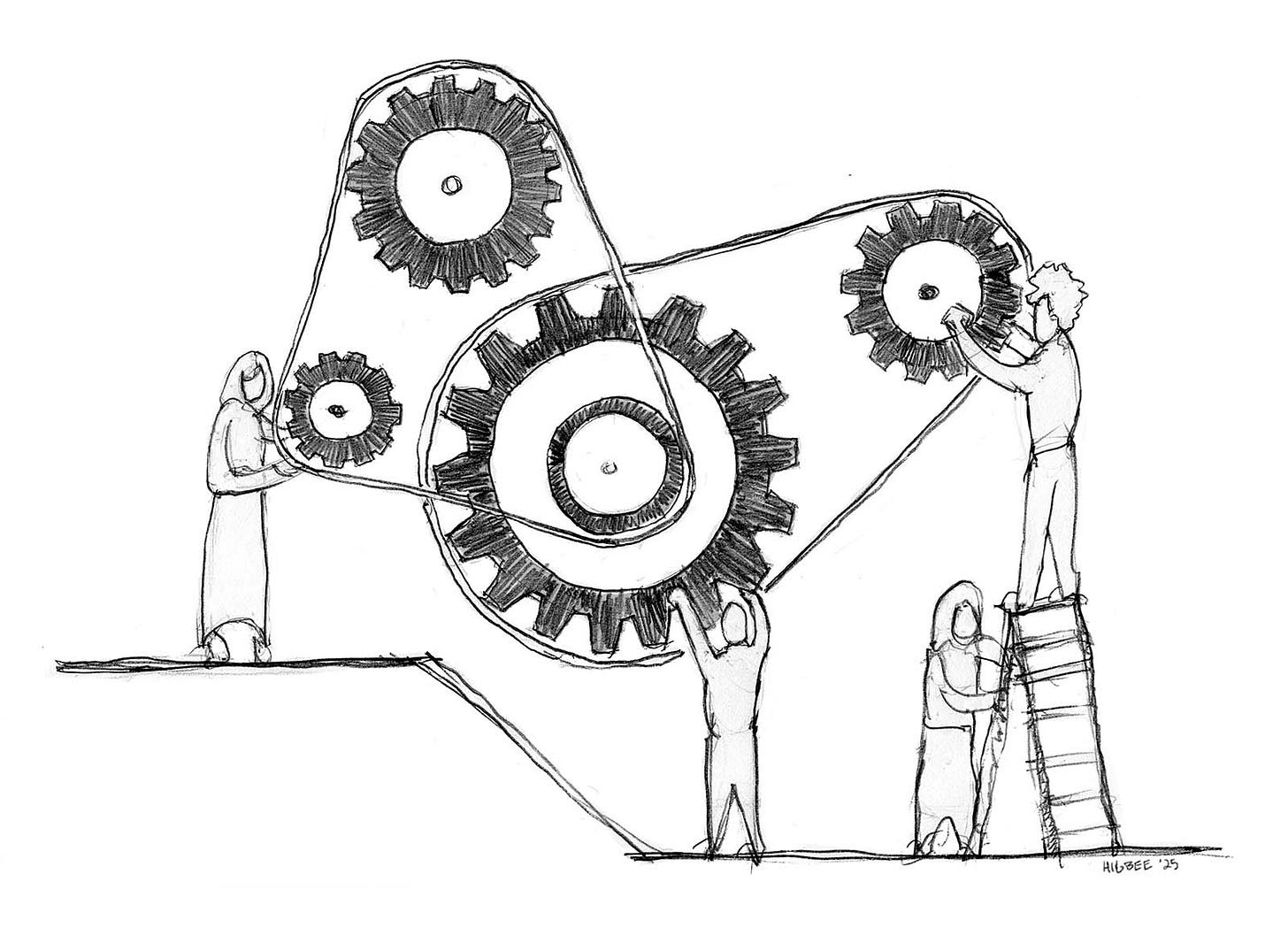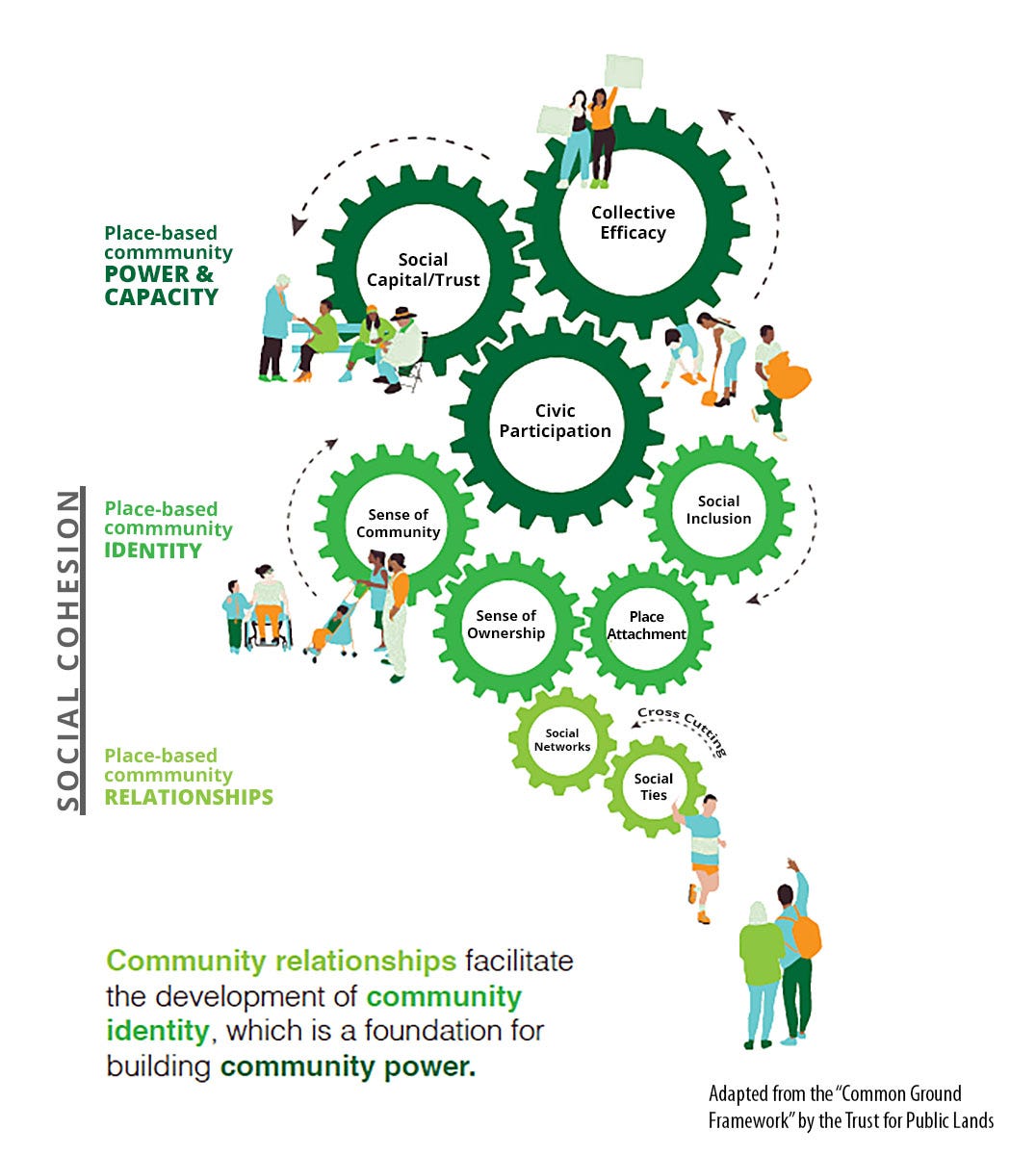How (and How Not To) Work with Community-Based Organizations
And why they’re critical to community power. (Reading Time: 6 minutes)
Let’s talk about community power.
In community engagement, power is most often referenced in frameworks like the IAP2 Spectrum, or its predecessor Arnstein’s Ladder. These frameworks place empowerment as our most aspirational goal when working with communities. They ask, “How do we put decision making in the hands of a community for a design, planning, or policy project?”
This is good stuff. And it has lots of value for a field of practice rampant with checkbox and token approaches to community engagement.
But this is a limited view of community power. It applies only to decision making within a project. What happens when your project is done? Have you supported a community’s enduring capacity to shape their own future?
This kind of power requires a bigger view. That’s the significance of the Trust for Public Land’s “Common Ground” Framework we discussed in my last post, “This Simple Infographic about Community Explains Everything.” It’s a guide for understanding how our engagement work contributes to strong communities. If you need a refresher, here’s my revised version of their infographic again:
Most community engagement processes are lucky to even turn some of the smallest gears of community relationships.
With intention and the right approaches, engagement can foster community relationships and cultivate community identity. These are the socially cohesive outcomes represented in the infographic’s bottom two levels. This is much of what I write about in this Substack.
But what about those upper gears of community power and capacity, community efficacy, and social capital?
The answer lies with community-based organizations (CBO’s).
There’s a reason those upper gears are REALLY big. It takes a lot to get them going. And once they’re spinning, they have lots of momentum.
CBO’s can help us build the capacity and structure for perpetual community power. CBO’s are often applying elbow grease to long-term community-building within their place-based communities. They’ve already built, or can build, the engines to keep those gears turning.
Let’s update our infographic again with this in mind:
Some readers might remember the Trajectory of Community Engagement I proposed last year, inspired by a similar trajectory for sustainable design. In case you are wondering, it intersects with the Common Ground Framework kind of like this:
Okay, enough with the graphics!
Some engagement practitioners are catching on to the importance of working with CBO’s.
However, I see these efforts going astray in two ways:
It’s often Needs-Based
Helping underserved communities meet their needs is a standard strategy in the pursuit of equitable community engagement. This typically means working with a CBO tackling a specific community need.
I don’t want to discount the value of this work. But needs-based approaches are inherently problematic. I covered the reasons in a previous post, “Beyond Authentic and Equitable Engagement Part 2,”
Just because it’s a CBO, doesn’t mean that it’s turning those gears of community relationships, identity, or power. Needs-based CBO’s frequently have their head down with a service-based model, chipping away at some issue within their community.
If we are interested in socially regenerative outcomes, then we need to be clear-eyed about what CBO’s we rope into our engagement work. Which ones are forging social relationships and strengthening social identity? Which ones are organizing for enduring community capacity and power?
When it comes to community power, not all CBOs are the same.
It’s Used as a Substitute for Broader Engagement
A lot of community engagement processes use CBO’s as a shortcut. It is assumed that a CBO reflects its wider community simply because it is a community-based organization.
Yes, involving CBO’s in a community engagement process can have a lot of value. This is especially true early on. CBO’s may provide critical insights into a community, guidance on how best to structure your community conversation, and assist with outreach.
However, CBO’s represent a limited slice of any given place-based community. They often have their own agendas and biases. Even if couched in a broader community mission, the individual folks from the CBO who participate don’t necessarily share a community’s same dreams and priorities.
CBO’s do not equal a place-based community.
I’ve seen this frequently with the surge of equitable-oriented work spurred by the Black Lives Matter movement. BIPOC led CBO’s are used to fast track the work of engaging traditionally unrepresented communities. This is often at the expense of more broadly inclusive engagement processes.
Sadly, this approach perpetuates an essentialist and generalist approach to race and ethnicity. It treats race and ethnicity as something that entirely defines the lives and experiences of those groups. It disrespects the broad range of identities and perspectives within these groups.
While more complex and time consuming, it’s crucial that we aspire to capture the views of as many individuals as possible within a place-based community, irrespective of whatever identity group they may belong to.
So then, there are two potential routes if we want to support community power through our engagement work.
1. Support Existing CBOs that are Contributing to Social Cohesion and Power
Using a discerning eye, we can identify existing CBO’s that support place-based social cohesion and community power.
Many communities are pregnant with such groups. Which of them could benefit from the spark of electricity a project-based community engagement process brings?
Most importantly, how is that relationship reciprocal? If a CBO brings their communities into the process, how are you helping them achieve their long-term community building goals? Is there organizational assistance, resources, or investments that you can put on the table?
2. Stand Up a New Group
This is a bigger lift, but may be necessary. Many communities are suffering from a deficit of community-based organizations. But it’s possible to catalyze engagement to launch new organizations that will incubate community power.
Sometimes this happens organically, especially when a project is bottom-up initiated. In these instances, communities are already mobilizing themselves. Engagement stewards can lend a helping hand with organizational support and resources.
But what about top-down projects? Say you are a local government starting a public planning or design process? Can you engender the formation of a new group?
I am imagining the response from folks who oversee top down engagement: “Wha!? This is so outside the scope of community engagement!”
I have two responses.
First, is the obvious, lukewarm, one:
Supporting community power can ensure long-term success of a project. Whether it’s a “friends-of” group stewarding a public space, or a community group keeping alive a vision for a shared future, it’s insurance on your investment.
But here’s the second, more raw, response:
Look around. We are witnessing an unprecedented collapse of our civil society. And the path towards social renewal is from the bottom up, starting in our place-based communities. This is our time step-up and to think differently about our work. Whether local governments, philantrophies, or businesses, we all have a stake in ensuring powerful, connected, inclusive place-based communities. Let’s radically reorient our missions. The keystones are CBO’s.
Project-based engagement can bring an incredible surge of energy into a community. It’s veritable nuclear fusion for community-building. Let’s capture it and channel it into engines of social regeneration.
What Else I’m Reading
“An Alternative to Antiracism” by Eboo Patel in Sapir
A potluck nation! Eboo Patel provides this wonderful metaphor in his appeal for a pluralistic future. Check out his recent “An Alternative to Antiracism” piece in Sapir.
“Potlucks are civic spaces that both embody and celebrate pluralism. They rely on the contributions of a diverse community. If people don’t bring an offering, the potluck doesn’t exist. If everyone brings the same thing, the potluck is boring. And what a nightmare it would be if you brought your best dish to a potluck and you were met at the door with a giant machine that melted it into the same bland goo as everybody else’s best dish.”
“The Connection Opportunity: Insights for Bringing American’s Together Across Differences.” by More in Common
If you don’t follow the More in Common US Substack, your missing out. More in Common publishes rigorous research about what American’s have in common, and dispels common misconceptions driven by polarization.
Their latest report is a doozy. I’m thinking it might make good fodder for a future post, so for the moment I’ll leave here for you to read and draw your own conclusions. Take a look!
“Want to Bridge Divides? You’re Not Alone—Most Americans Do Too” by Linda Tropp in Fulcrum
As Yascha Mounk explains in “The Great Experiment”, diverse democracies have long struggled to contend with difference effectively—but they can only endure by investing in the social infrastructure that makes connections across differences possible.
Linda Tropp provides just about the perfect commentary to More in Common’s aforementioned report. Don’t miss it!
DO YOU HAVE A STORY TO SHARE?
Do you have a great example of how a community engagement process helped a community restitch its social fabric, or go from “Us vs Them” to “We.” Or, an example of how a community engagement process went off the rails? I’m collecting stories, and I’d love to talk to you. Please reach out.







This is an insightful read, thank you.
Two questions - do you work with a specific definition of 'community based organizations'?
And do you have experience doing this work in places that don't have a deep tradition of place based engagement? Where do you start? How do you plant seeds?